| [1] |
Yang Xin, Jin Zhe, Feng Xu, Lu Bing.
The current situation of knowledge and attitudes towards organ, eye tissue, body donation of residents in Shenyang
[J]. Chinese Journal of Tissue Engineering Research, 2021, 25(5): 779-784.
|
| [2] |
Xu Zhongzhong, Yu Xiaofei, Wang Liya.
In vitro culture of human corneal epithelial stem cells using modified explant culture
[J]. Chinese Journal of Tissue Engineering Research, 2020, 24(25): 4012-4017.
|
| [3] |
Zhang Yuan, Zeng Min, Zhai Bo.
Vitrification-based cryopreservation of tissues: strengths
and existing problems
[J]. Chinese Journal of Tissue Engineering Research, 2020, 24(23): 3751-3755.
|
| [4] |
Zhao Jianfeng, Geng Yu, Chen Qianbo, Yang Jinghui, Li Yan.
Changes in insulin resistance and inflammatory factors in
cataract patients with glaucoma after phacoemulsification and trabeculectomy: a
self-controlled trial
[J]. Chinese Journal of Tissue Engineering Research, 2020, 24(11): 1750-1755.
|
| [5] |
Liu Zhiling, Gao Minghong, Chen Yingxin.
Bio-engineering cornea versus human donor cornea in the treatment of fungal corneal ulcer
[J]. Chinese Journal of Tissue Engineering Research, 2020, 24(10): 1563-1569.
|
| [6] |
Yuan Bo, Wang Zhiwei, Tang Yifan, Zhou Shengyuan, Chen Xiongsheng, Jia Lianshun.
Construction of polycaprolactone-tricalcium phosphate with different mixture ratios using three-dimensional printing technology and its osteoinductivity in vitro
[J]. Chinese Journal of Tissue Engineering Research, 2019, 23(6): 821-826.
|
| [7] |
Sun Liang, Xu Lin.
Comparison of the fixation effects of three kinds of fixatives on mouse eyeball tissue
[J]. Chinese Journal of Tissue Engineering Research, 2019, 23(34): 5492-5496.
|
| [8] |
Chen Xinyan, Qin Xiao, Zhang Haixia, Li Lin.
Effect of collagenase type II on the biomechanical properties of rabbit cornea
[J]. Chinese Journal of Tissue Engineering Research, 2019, 23(22): 3556-3561.
|
| [9] |
Wei Wei, Liu Yanfei, Zhang Ling, Xiong Na .
Self-assembling peptide hydrogel: hemostatic effect and mechanism
[J]. Chinese Journal of Tissue Engineering Research, 2019, 23(2): 310-316.
|
| [10] |
Zhang Minbo, Peng Qifeng, Ma Yaping, Kong Weijun, Liao Wenbo.
Physical properties and biocompatibility of 3D printed bone microparticle/poly(lactic-co-glycolic acid) scaffold
[J]. Chinese Journal of Tissue Engineering Research, 2019, 23(14): 2215-2222.
|
| [11] |
Li Zhi, Tan Chunhua, Cai Xianhua, Wang Huasong, Ding Xiaoming, Zhao Yanhong.
Fabrication and biocompatibility assessment of the scaffold with biomimetic interconnected macropore structure
[J]. Chinese Journal of Tissue Engineering Research, 2019, 23(14): 2223-2227.
|
| [12] |
Bai Yulong, Gao Yufeng, Zhong Hongbin, Zhao Yantao, Guo Ruizhou, Li Li.
Allogeneic and xenogeneic tissue repair materials: how to choose a suitable virus inactivation process
[J]. Chinese Journal of Tissue Engineering Research, 2019, 23(14): 2261-2268.
|
| [13] |
Luo Kai, Yang Yafeng, Ma Teng, Xia Bing, Huang Liangliang, Huang Jinghui, Luo Zhuojing.
Effects of perfluorotributylamine/alginate/bioglass biomaterials on viability and osteogenic differentiation of adipose-derived stem cells
[J]. Chinese Journal of Tissue Engineering Research, 2019, 23(13): 1995-2001.
|
| [14] |
Wang Yuanyuan, Song Wenshan, Yu Dejun, Dai Yuankun, Li Bafang.
Preparation and evaluation of fish skin acellular dermal matrix for oral guided tissue regeneration
[J]. Chinese Journal of Tissue Engineering Research, 2019, 23(10): 1526-1532.
|
| [15] |
Liu Shaoyang, Zou Hanlin .
Biocompatibility of anodic titanium oxide: an experimental research
[J]. Chinese Journal of Tissue Engineering Research, 2019, 23(10): 1575-1580.
|



